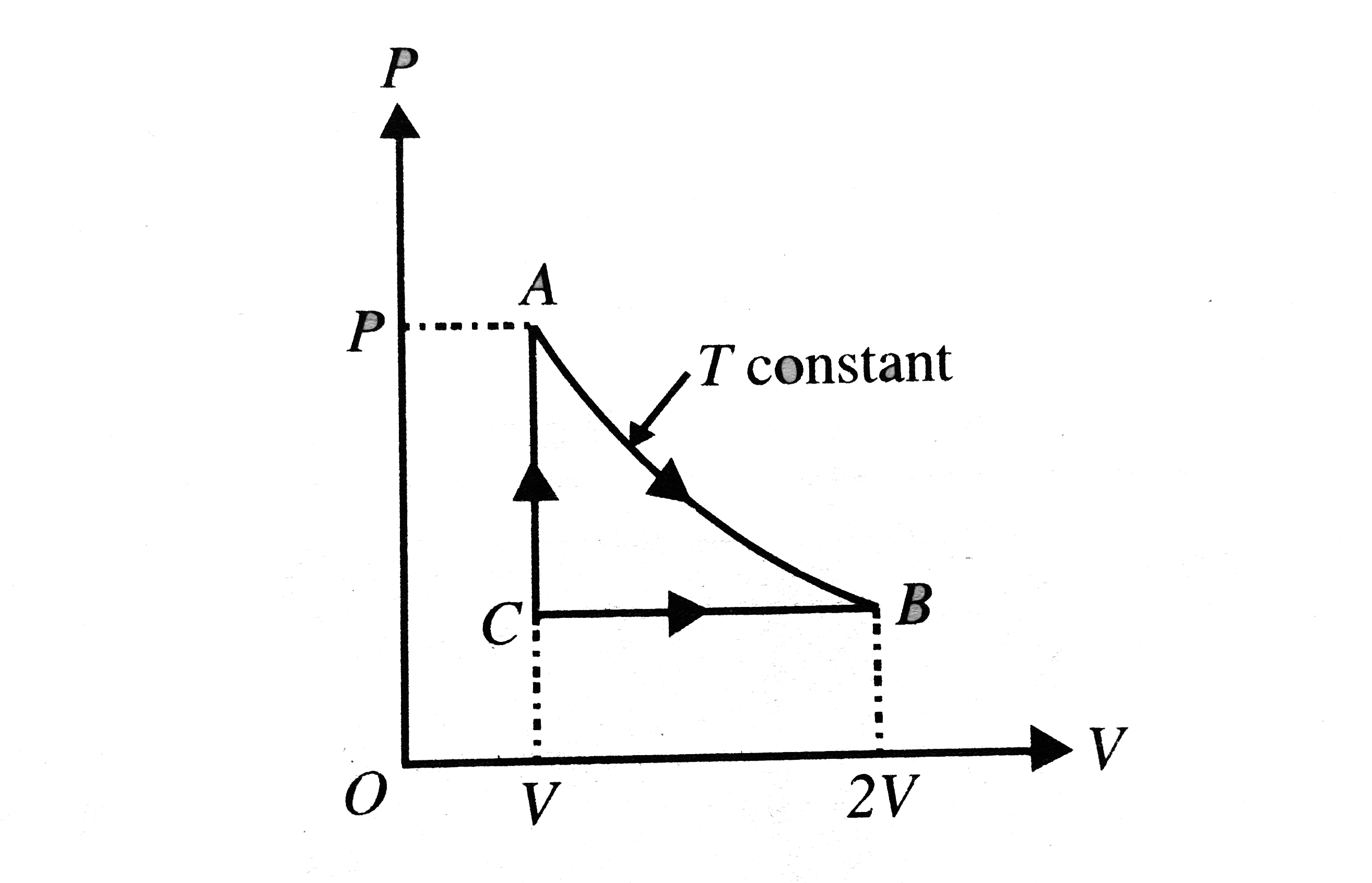An ideal gas expands at a constant pressure of 7.0 atm from 280 mL to 630 mL. Heat then flows out of the gas, at constant volume, and the pressure and temperature are allowed to drop until the temperature reaches its original value. Calculate the total work done by the gas in the process
The correct Answer is:248 J
To solve the problem of calculating the total work done by the gas during its expansion and subsequent cooling, we can break it down into steps.
1. Identify the Process: The gas undergoes two processes:
- Expansion at Constant Pressure: The gas expands from 280 mL to 630 mL at a constant pressure of 7.0 atm.
- Cooling at Constant Volume: The gas cools down at constant volume until the temperature reaches its original value.
2. Calculate the Work Done During Expansion:
The work done (W) by the gas during expansion at constant pressure is given by the formula:
W=P×ΔV
where P is the pressure and ΔV is the change in volume.
- Convert the volumes from mL to L:
- Initial Volume, Vi=280mL=0.280L
- Final Volume, Vf=630mL=0.630L
- Calculate the change in volume:
ΔV=Vf−Vi=0.630L−0.280L=0.350L
- Now, substitute the values into the work done formula:
W=7.0atm×0.350L=2.45L⋅atm
3. Consider the Cooling Process:
During the cooling process at constant volume, the work done is zero because there is no change in volume (ΔV=0). Therefore:
Wcooling=0
4. Total Work Done:
The total work done by the gas in the entire process is simply the work done during the expansion, as no work is done during the cooling phase:
Wtotal=Wexpansion+Wcooling=2.45L⋅atm+0=2.45L⋅atm
Final Answer:
The total work done by the gas in the process is 2.45 L·atm.
- Expansion at Constant Pressure: The gas expands from 280 mL to 630 mL at a constant pressure of 7.0 atm.
- Cooling at Constant Volume: The gas cools down at constant volume until the temperature reaches its original value.
The work done (W) by the gas during expansion at constant pressure is given by the formula:
W=P×ΔV
where P is the pressure and ΔV is the change in volume.
- Initial Volume, Vi=280mL=0.280L
- Final Volume, Vf=630mL=0.630L
ΔV=Vf−Vi=0.630L−0.280L=0.350L
W=7.0atm×0.350L=2.45L⋅atm
During the cooling process at constant volume, the work done is zero because there is no change in volume (ΔV=0). Therefore:
Wcooling=0
The total work done by the gas in the entire process is simply the work done during the expansion, as no work is done during the cooling phase:
Wtotal=Wexpansion+Wcooling=2.45L⋅atm+0=2.45L⋅atm
The total work done by the gas in the process is 2.45 L·atm.
Topper's Solved these Questions
- THERMODYNAMICS LAWS & SPECIFIC HEATS OF GASES Book:PHYSICS GALAXY - ASHISH ARORAChapter:THERMODYNAMICS LAWS & SPECIFIC HEATS OF GASES Exercise:Practice Exercise 3.1
Explore 6 Videos
- THERMODYNAMICS LAWS & SPECIFIC HEATS OF GASES Book:PHYSICS GALAXY - ASHISH ARORAChapter:THERMODYNAMICS LAWS & SPECIFIC HEATS OF GASES Exercise:Practice Exercise 3.3
Explore 10 Videos
- THERMODYNAMICS LAWS & SPECIFIC HEATS OF GASES Book:PHYSICS GALAXY - ASHISH ARORAChapter:THERMODYNAMICS LAWS & SPECIFIC HEATS OF GASES Exercise:Advance MCQs with One or More Options Correct
Explore 10 Videos
- PHOTOELECTRIC EFFECT AND MATTER WAVESBook:PHYSICS GALAXY - ASHISH ARORAChapter:PHOTOELECTRIC EFFECT AND MATTER WAVESExercise:Unsolved numerical problems
Explore 42 Videos
- WAVE OPTICSBook:PHYSICS GALAXY - ASHISH ARORAChapter:WAVE OPTICSExercise:Unsolved Numerical Problems
Explore 28 Videos
Similar Questions
An ideal gas expands at a constant pressure of 7.0 atm from 280 mL to 630 mL. Heat then flows out of the gas, at constant volume, and the pressure and temperature are allowed to drop until the temperature reaches its original value. Calculate the total heat flow into the gas.
View SolutionOne mole of a gas is carried through the cycle shown in Fig. The gas expands at constant temperature T from volume V to 2V. It is them compressed to the initial volume at constant pressure and is finally brought back to its original state by heating at constant volume. Calculate the work done by the gas in complete cycle.

View Solution
Knowledge Check
If a gas at constant temperature and pressure expand then its
AInternal energy increases and then decreasesBInternal energy increasesCinternal energy remains the sameDinternal energy decreasesIf a gas, at constant temperature and pressure expands, then its
Aentropy first increases and then decreasesBinternal energy increasesCinternal energy remains the sameDinternal energy decreasesIf a gas, at constant temperature and pressure expands, then its
AEnthropy increases and then decreaseBInternal energy increasesCInternal energy remains the sameDInternal energy decreases
One mole of an ideal gas is heated from 273K to 546K at constant pressure of 1 atmosphere. Calculate the work done by the gas in the process.
View SolutionTwo moles of a certain ideal gas at 300K is cooled at constant volume so that the pressure is reduced to half the original value. Now the gas is heated at constant pressure so that its temperature becomes equal to the initial temperature. Find the total amount of heat absorbed by the gas in the process.
View SolutionA gas expands by 0.5L against a constant pressure of 1atm. Calculate the work done in joule and calorie.
View SolutionIf a gas, at constant temperature and pressure expands, then its
View SolutionA gas can expand from 100mL to 250mL under a constant pressure of 2 atm. The work done by the gas is
View Solution

